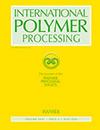菠萝叶(Ananas comosus)和剑麻(Agave sisalana)纤维增强混合环氧树脂复合材料的力学和摩擦学分析实验研究
IF 1.9
4区 工程技术
Q4 ENGINEERING, CHEMICAL
引用次数: 0
摘要
摘要 在许多工业应用中,天然纤维增强聚合物(NFRP)复合材料正在成为合成纤维复合材料的有力替代品。本研究的目的是考察不同重量分数的菠萝叶和剑麻纤维增强的混合环氧树脂复合材料的机械和摩擦学特性,包括拉伸、弯曲、冲击、磨损、硬度和吸水性。首先,用 5% 的氢氧化钠处理菠萝叶和剑麻纤维。菠萝叶和剑麻纤维与环氧树脂及其固化剂混合物的重量比分别为 0、10、15、20 和 30%,其中环氧树脂及其固化剂混合物的重量比恒定为 70%。为了制造用菠萝和剑麻纤维增强的混合环氧树脂复合材料,使用了环氧树脂作为粘合剂。按照 ASTM 标准对混合复合材料进行了不同类型的测试。测试结果与单菠萝纤维和剑麻纤维制成的复合材料进行了对比。与其他复合材料样品相比,15:15 复合材料样品表现出最佳的机械和摩擦学质量,包括最高的拉伸强度、抗冲击性、抗弯强度、硬度、吸水性和耐磨性。使用扫描电子显微镜(SEM)对纤维/基质的粘附性进行了研究。15:15 复合材料样品主要表现出机械和摩擦学特性,使由此产生的复合材料更易于在结构和汽车应用中使用。本文章由计算机程序翻译,如有差异,请以英文原文为准。
Experimental investigation on mechanical and tribological analysis of pineapple leaf (Ananas comosus) and sisal (Agave sisalana) fibers reinforced hybrid epoxy composites
Abstract In many industrial applications, natural-fiber-reinforced polymer (NFRP) composites are emerging as a strong substitute for composites based on synthetic fibers. The goal of this study was to examine the mechanical and tribological characteristics, including tensile, flexural, impact, wear, hardness, and water absorption, of hybrid epoxy composites reinforced with pineapple leaf and sisal fibers at various weight fractions. First, 5 % sodium hydroxide was used to treat the pineapple leaf and sisal fibers. With a composition of 0, 10, 15, 20, and 30 wt% of pineapple leaf and sisal fibers to the epoxy resin and its hardener mixture, which had a constant weight ratio of 70 %, hybrid composites were fabricated using the compression moulding process. To create a hybrid epoxy composite reinforced with pineapple and sisal fiber, epoxy resin was used as the binder. Different types of testing were performed on the hybrid composites following ASTM standards. The outcomes were contrasted with composites made from mono-pineapple and sisal fiber composites. In comparison to other composite samples, the 15:15 composite sample exhibited the best mechanical and tribological qualities, including the highest tensile strength, impact resistance, flexural strength, hardness, water absorption resistance, and wear resistance. Using a scanning electron microscope (SEM), the fiber/matrix adhesion was investigated. The 15:15 composite sample exhibits primarily mechanical and tribological properties, making the resultant composite material simpler to use in structural and automotive applications.
求助全文
通过发布文献求助,成功后即可免费获取论文全文。
去求助
来源期刊

International Polymer Processing
工程技术-高分子科学
CiteScore
2.20
自引率
7.70%
发文量
62
审稿时长
6 months
期刊介绍:
International Polymer Processing offers original research contributions, invited review papers and recent technological developments in processing thermoplastics, thermosets, elastomers and fibers as well as polymer reaction engineering. For more than 25 years International Polymer Processing, the journal of the Polymer Processing Society, provides strictly peer-reviewed, high-quality articles and rapid communications from the leading experts around the world.
 求助内容:
求助内容: 应助结果提醒方式:
应助结果提醒方式:


